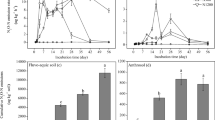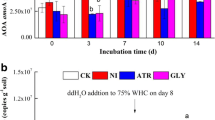Abstract
Purpose
Human disturbance is a major culprit driving imbalances in the biological transformation of nitrogen from the nonreactive to the reactive pool and is therefore one of the greatest concerns for nitrogen (N) cycling. The objective of this study was to compare potential nitrification rates and the abundance of ammonia oxidizers responsible for nitrification, with the amendment of external N in different agricultural soils.
Materials and methods
Three typical Chinese agricultural soils, QiYang (QY) acid soil, ShenYang (SY) neutral soil, and FengQiu (FQ) alkaline soil, were amended with 0, 20, 150, and 300 μg NH4 +-N g−1 soil and incubated for 40 days. The abundance of ammonia oxidizing bacteria (AOB) and archaea (AOA) at the end of incubation in the soil microcosms was determined using the real-time PCR.
Results and discussion
There was a significant decrease in ammonium concentration in the QY soil from the highest to the lowest N-loading treatments, while no significant difference in ammonium concentrations was detected among the different N-loading treatments for the SY and FQ soils. A significantly higher potential nitrification rate (PNR) was observed in the FQ soil while lowest PNR was found in the QY soil. Quantitative PCR analysis of AOB amoA genes demonstrated that AOB abundance was significantly higher in the high N-loading treatments than in the control for the QY soil only, while no significant difference among treatments in the SY and FQ soils. A significant positive correlation between PNR and AOB amoA abundance, however, was found for the SY and FQ soils, but not for the QY soil. Little difference in AOA amoA abundance between different N-loading treatments was observed for all the soils.
Conclusions
This study suggested that ammonia oxidation capacity in the FQ and SY soils was higher than those in the QY soil with the addition of ammonium fertilizer for a short-term. These findings indicated that understanding the differential responses of biological nitrification to varying input levels of ammonium fertilizer is important for maximizing N use efficiency and thereby improving agricultural fertilization management.




Similar content being viewed by others
References
Brochier-Armanet C, Boussau B, Gribaldo S, Forterre P (2008) Mesophilic crenarchaeota: Proposal for a third archaeal phylum, the thaumarchaeota. Nat Rev Microbiol 6:245–252
Chen X, Zhang LM, Shen JP, Xu ZH, He JZ (2010) Soil type determines the abundance and community structure of ammonia-oxidizing bacteria and archaea in flooded paddy soils. J Soils Sediments 10:1510–1516
Di HJ, Cameron KC, Shen JP, Winefield CS, O’Callaghan M, Bowatte S, He JZ (2009) Nitrification driven by bacteria and not archaea in nitrogen-rich grassland soils. Nat Geosci 2:621–624
Di HJ, Cameron KC, Shen JP, Winefield CS, O’Callaghan M, Bowatte S, He JZ (2010) Ammonia-oxidizing bacteria and archaea grow under contrasting soil nitrogen conditions. FEMS Microbiol Ecol 72:386–394
Enwall K, Philippot L, Hallin S (2005) Activity and composition of the denitrifying bacterial community respond differently to long-term fertilization. Appl Environ Microbiol 71:8335–8343
Fernandez-Guerra A, Casamayor EO (2012) Habitat-associated phylogenetic community patterns of microbial ammonia oxidizers. PLoS ONE 7:e47330
Francis CA, Roberts KJ, Beman JM, Santoro AE, Oakley BB (2005) Ubiquity and diversity of ammonia-oxidizing archaea in water columns and sediments of the ocean. Proc Natl Acad Sci U S A 102:14683–14688
Girvan MS, Bullimore J, Pretty JN, Osborn AM, Ball AS (2003) Soil type is the primary determinant of the composition of the total and active bacterial communities in arable soils. Appl Environ Microbiol 69:1800–1809
Gruber N, Galloway JN (2008) An earth-system perspective of the global nitrogen cycle. Nature 451:293–296
Gubry-Rangin C, Hai B, Quince C, Engel M, Thomson BC, James P, Schloter M, Griffiths RI, Prosser JI, Nicol GW (2011) Niche specialization of terrestrial archaeal ammonia oxidizers. Proc Natl Acad Sci U S A 108:21206–21211
Haynes RJ (1986) Chapter 3 - Nitrification. In: Haynes RJ (ed) Mineral nitrogen in the plant–soil system. Academic Press, pp 127–165
He JZ, Shen JP, Zhang LM, Zhu YM, Zheng YG, Xu MG, Di HJ (2007) Quantitative analyses of the abundance and composition of ammonia-oxidizing bacteria and ammonia-oxidizing archaea of a Chinese upland red soil under long-term fertilization practices. Environ Microbiol 9:2364–2374
He JZ, Hu HW, Zhang LM (2012) Current insights into the autotrophic thaumarchaeal ammonia oxidation in acidic soils. Soil Biol Biochem 55:146–154
Hu HW, Zhang LM, Dai Y, Di HJ, He JZ (2013) pH-dependent distribution of soil ammonia oxidizers across a large geographical scale as revealed by high-throughput pyrosequencing. J Soils Sediments 13:1439–1449
Hu HW, Xu ZH, He JZ (2014) Ammonia-oxidizing archaea play a predominant role in acid soil nitrification. Adv Agron 125:261–302
Kowalchuk GA, Stephen JR (2001) Ammonia-oxidizing bacteria: a model for molecular microbial ecology. Annu Rev Microbiol 55:485–529
Kurola J, Salkinoja-Salonen M, Aarnio T, Hultman J, Romantschuk M (2005) Activity, diversity and population size of ammonia-oxidising bacteria in oil-contaminated landfarming soil. FEMS Microbiol Lett 250:33–38
Levicnik-Hofferle S, Nicol GW, Ausec L, Mandic-Mulec I, Prosser JI (2012) Stimulation of thaumarchaeal ammonia oxidation by ammonia derived from organic nitrogen but not added inorganic nitrogen. FEMS Microbiol Ecol 80:114–123
Martens-Habbena W, Berube PM, Urakawa H, de la Torre JR, Stahl DA (2009) Ammonia oxidation kinetics determine niche separation of nitrifying archaea and bacteria. Nature 461:976–U234
Nicol GW, Leininger S, Schleper C, Prosser JI (2008) The influence of soil pH on the diversity, abundance and transcriptional activity of ammonia oxidizing archaea and bacteria. Environ Microbiol 10:2966–2978
Offre P, Prosser JI, Nicol GW (2009) Growth of ammonia-oxidizing archaea in soil microcosms is inhibited by acetylene. FEMS Microbiol Ecol 70:99–108
Okano Y, Hristova KR, Leutenegger CM, Jackson LE, Denison RF, Gebreyesus B, Lebauer D, Scow KM (2004) Application of real-time PCR to study effects of ammonium on population size of ammonia-oxidizing bacteria in soil. Appl Environ Microbiol 70:1008–1016
Phillips CJ, Harris D, Dollhopf SL, Gross KL, Prosser JI, Paul EA (2000) Effects of agronomic treatments on structure and function of ammonia-oxidizing communities. Appl Environ Microbiol 66:5410–5418
Schauss K, Focks A, Leininger S, Kotzerke A, Heuer H, Thiele-Bruhn S, Sharma S, Wilke BM, Matthies M, Smalla K, Munch JC, Amelung W, Kaupenjohann M, Schloter M, Schleper C (2009) Dynamics and functional relevance of ammonia-oxidizing archaea in two agricultural soils. Environ Microbiol 11:446–456
Schleper C (2010) Ammonia oxidation: Different niches for bacteria and archaea? ISME J 4:1092–1094
Shen JP, Zhang LM, Zhu YG, Zhang JB, He JZ (2008) Abundance and composition of ammonia-oxidizing bacteria and ammonia-oxidizing archaea communities of an alkaline sandy loam. Environ Microbiol 10:1601–1611
Shen JP, Zhang LM, Guo JF, Ray JL, He JZ (2010) Impact of long-term fertilization practices on the abundance and composition of soil bacterial communities in Northeast China. Appl Soil Ecol 46:119–124
Shen JP, Zhang LM, Di HJ, He JZ (2012) A review of ammonia-oxidizing bacteria and archaea in Chinese soils. Front Microbiol 3:296
Shen JP, Cao P, Hu HW, He JZ (2013) Differential response of archaeal groups to land use change in an acidic red soil. Sci Total Environ 461:742–749
Shen JP, Xu ZH, He JZ (2014) Frontiers in the microbial processes of ammonia oxidation in soils and sediments. J Soils Sediments 14:1023–1029
Silva MCPE, Poly F, Guillaumaud N, van Elsas JD, Salles JF (2012) Fluctuations in ammonia oxidizing communities across agricultural soils are driven by soil structure and pH. Front Microbiol 3:77
Singh BK, Bardgett RD, Smith P, Reay DS (2010) Microorganisms and climate change: Terrestrial feedbacks and mitigation options. Nat Rev Microbiol 8:779–790
Ste-Marie C, Pare D (1999) Soil, pH and N availability effects on net nitrification in the forest floors of a range of boreal forest stands. Soil Biol Biochem 31:1579–1589
Suzuki I, Dular U, Kwok SC (1974) Ammonia or ammonium ion as substrate for oxidation by Nitrosomonas europaea cells and extracts. J Bacteriol 120:556–558
Taylor AE, Zeglin LH, Wanzek TA, Myrold DD, Bottomley PJ (2012) Dynamics of ammonia-oxidizing archaea and bacteria populations and contributions to soil nitrification potentials. ISME J 6:2024–2032
Verhamme DT, Prosser JI, Nicol GW (2011) Ammonia concentration determines differential growth of ammonia-oxidising archaea and bacteria in soil microcosms. ISME J 5:1067–1071
Wessen E, Soderstrom M, Stenberg M, Bru D, Hellman M, Welsh A, Thomsen F, Klemedtson L, Philippot L, Hallin S (2011) Spatial distribution of ammonia-oxidizing bacteria and archaea across a 44-hectare farm related to ecosystem functioning. ISME J 5:1213–1225
Wu YC, Lu L, Wang BZ, Lin XG, Zhu JG, Cai ZC, Yan XY, Jia ZJ (2011) Long-term field fertilization significantly alters community structure of ammonia-oxidizing bacteria rather than archaea in a paddy soil. Soil Sci Soc Am J 75:1431–1439
Yao HY, Campbell CD, Chapman SJ, Freitag TE, Nicol GW, Singh BK (2013) Multi-factorial drivers of ammonia oxidizer communities: Evidence from a national soil survey. Environ Microbiol 15:2545–2556
Yuan F, Ran W, Shen QR, Wang DZ (2005) Characterization of nitrifying bacteria communities of soils from different ecological regions of China by molecular and conventional methods. Biol Fertil Soils 41:22–27
Zhang LM, Offre PR, He JZ, Verhamme DT, Nicol GW, Prosser JI (2010) Autotrophic ammonia oxidation by soil thaumarchaea. Proc Natl Acad Sci U S A 107:17240–17245
Zhang LM, Hu HW, Shen JP, He JZ (2012) Ammonia-oxidizing archaea have more important role than ammonia-oxidizing bacteria in ammonia oxidation of strongly acidic soils. ISME J 6:1032–1045
Acknowledgments
We appreciate the helpful suggestions and English improvements from Dr. Jessica L. Ray, Uni Research AS, Norway. The assistances in sampling by staff at the Qiyang (QY), Fengqiu (FQ) and Shenyang (SY) experiment stations are sincerely appreciated. This work was financially support by the Natural Science Foundation of China (41371265) and the Strategic Priority Research Program of the Chinese Academy of Sciences (XDB15020200).
Author information
Authors and Affiliations
Corresponding author
Additional information
Responsible editor: Ian Anderson
Rights and permissions
About this article
Cite this article
Shen, JP., Zhang, LM. & He, JZ. Contrasting response of nitrification capacity in three agricultural soils to N addition during short-term incubation. J Soils Sediments 14, 1861–1868 (2014). https://doi.org/10.1007/s11368-014-0968-3
Received:
Accepted:
Published:
Issue Date:
DOI: https://doi.org/10.1007/s11368-014-0968-3




